
Volvo Penta casts its own blocks from proprietary alloys, and mills and assembles them with precision in a state-of-the-art factory in Skovde, Sweden. I visited that factory a few years ago on a day after the foundry had poured a dozen or so heads that were still cooling in a temperature-controlled chamber. Some were still glowing red.
Controlled cooling makes sure the iron is true to form and hard yet not brittle. A combination of skilled technicians, craftsmen and robotic assemblers mill each head to exact specifications and repeatedly and precisely set valve seats, springs and rocker arms while the technicians make final inspections and assembly touches to ensure each engine is as perfect as the one before it.
The D8 engines we tested in the Cruisers Yachts 54 Cantius were assembled there. Each cast-iron block has replaceable valve guides and seats. This gives each Volvo Penta engine a long life while ensuring that seasoned engines can later be brought back to life, refitted with new parts. The crankshaft is drop-forged, and its seven bearing surfaces are induction-heated and cooled for consistent hardness. The process uses electromagnetic charging to heat and then cool the surfaces for optimum hardness. Too much and they are brittle. Too little and they are soft, loosening over time. In the factory, all processes are computer-controlled and robotically executed while technicians monitor every step of the process to ensure the machinery is doing its proper job.
In our test, we found the six-cylinder double-overhead-valve engines boasted a midposition turbocharger, with induction ports on either end. The result is a quick, responsive spin up that, in turn, offers rapid acceleration.
And there was also a supercharger. The next obvious question: Why the supercharger too? For even more acceleration and enhanced joystick response in close quarters. The surpercharger kicks in, adding air to the combustion mix before the turbo spools up at higher rpm. All this is controlled by the Electronic Vessel Control system, which enables full integration of engine functions, from the helm and joystick to the contra-rotating IPS propsets. Even better, all this is monitored and even controlled when equipped with Volvo Penta’s Glass Cockpit system formed in partnership with Garmin Marine electronics.
If that’s not enough enticement, Volvo Penta D8 diesel engines are EPA Tier 3 and EU RCD Stage II compliant without losing the power you’re paying for, whether you connect them to shafts and struts or to Volvo Penta’s IPS drives.









